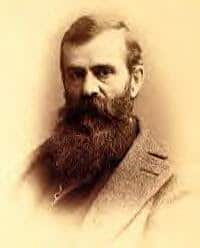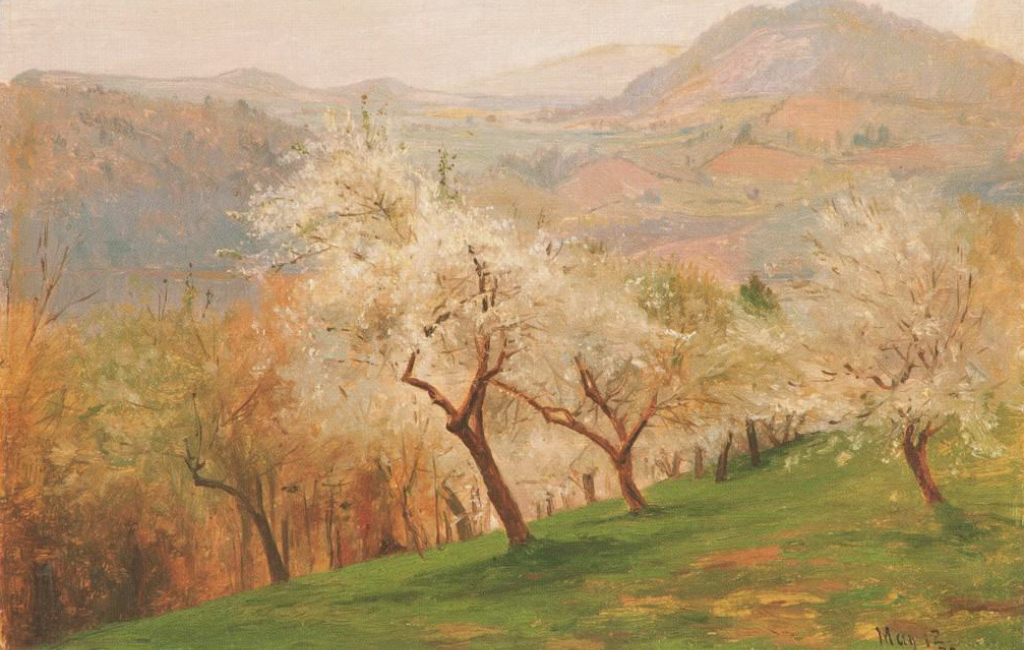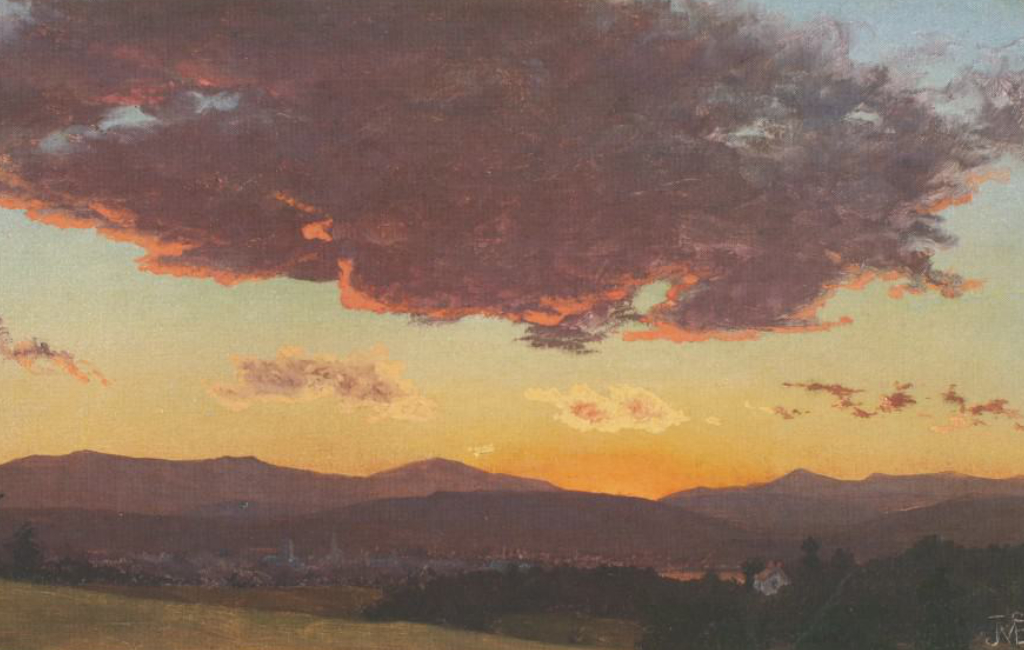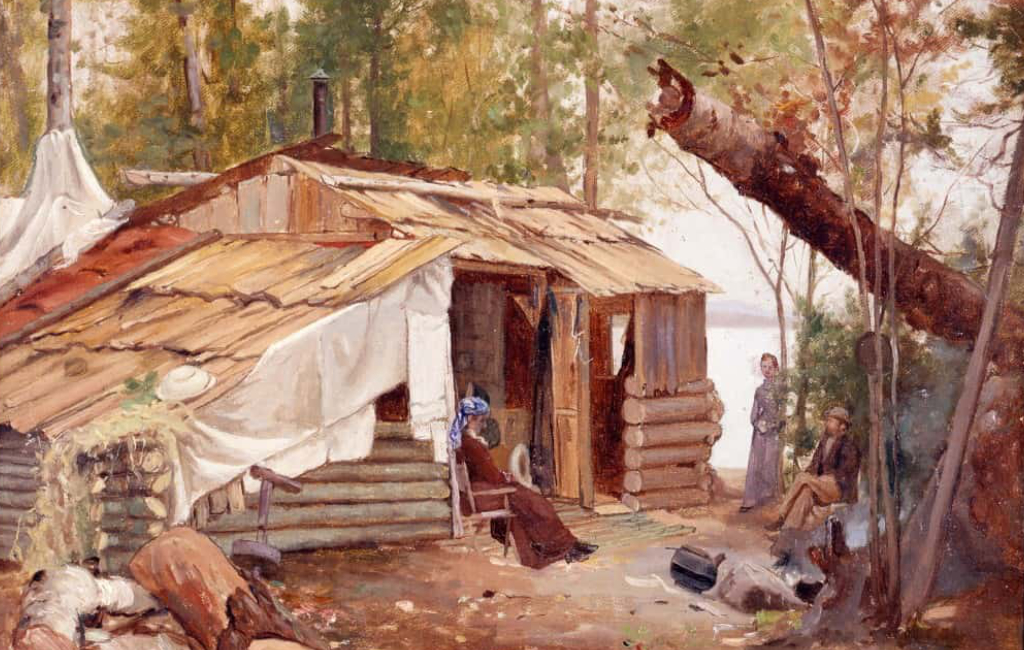Jervis McEntee and Church–Reflections on a Forty-Year Friendship
Valerie Balint, Associate Curator

Napoleon Sarony, Jervis McEntee ((1828-1891), c. 1867, albumen silver print, The Century Association, New York
This year Hudson River School devotees have the pleasure of attending two retrospective exhibitions about Rondout/Kingston native Jervis McEntee (1828-1891)—Jervis McEntee: Kingston’s Hudson River School Artist (Friends of Historic Kingston) and Jervis McEntee: Painter-Poet of the Hudson River School (Dorsky Museum at SUNY New Paltz). I was asked to lecture for the Friends of Historic Kingston about the association between Jervis McEntee and Frederic Church. It allowed me the chance to examine an affiliation which is often summarily defined by the fact that McEntee began his own professional career as a pupil of Church.
For scholars the journals Jervis McEntee kept almost daily between 1872 and 1890 have long provided a wealth of information about the American Art scene during this period. But as the curators of both McEntee exhibitions have aptly pointed out, most researchers in the past have read “at” the diaries looking for specific references rather than reading entirely through them for an overall picture of the artist and his life. I confess that in my fifteen years at Olana, I have often used this resource in this same, admittedly restrictive way —cherry picking those snippets about Church and Olana that informed a particular project. In preparing for my lecture I read through the Church-related diary entries chronologically and supplemented this with letters between Church and McEntee in the Olana research collection. The result was a better understanding of a rich and complex friendship between these two men which sustained over their entire adult lives—a forty year bond with interesting ebbs and flows. While the commentary about Church is one-sided, (Church is not a diarist), one gains insight none-the-less into these distinctly unique men and their relationship.
They met as young men and matured into elder statesmen of the American art scene, connected not only through their artistic pursuits, but socially as well. While they were perhaps not each other’s most intimate friend, the longevity of their relationship is interesting given their markedly different temperaments. Jervis was fun loving, but could be shy and unassuming, while Church was known by all for his confidence and ease in almost any situation.
Jervis McEntee’s first formal artistic instruction was as Church’s student in the winter of 1850-51. Church’s own star was already on the rise, and he was exhibiting and selling works with success. After his tutelage McEntee went to work in his hometown of Roundout (Kingston) in the flour and feed business and assisting on his parent’s farm. In 1854 he married Gertude Sawyer, and built a home on his parent’s property. In direct contrast to this domestic bliss, at this same time Church was embarking on expeditions to South America, from which the resulting paintings made him the most highly paid and critically acclaimed artist in the country.
The two artists artistically converged again in the late 1850s in the purpose built 10th Street Studio Building in New York which became the center of American artistic life. By this time McEntee had dedicated himself to becoming a professional artist. In 1860, Church married Isabel Carnes and bought a working farm just outside of Hudson, NY. The two artists had their family homes just under 30 miles from each other, and their City studios within the same building. While Church traveled with his family to Europe and the Middle East in 1867-69, McEntee, with his wife, was on his own sojourn with close friend, painter Sanford Gifford. They all spent the winter together in Rome; Jervis and Frederic secured studios in the same building. McEntee’s resulting paintings exhibit poetic sky effects perhaps influenced by proximity to the great celestial painter. A highlight of the trip is a collaborative painting The Arch of Titus which they completed together with figurative painter George Healy.
Prior to the trip, Church had secured the hilltop on his property, and knew he planned to build a significant house upon his return. McEntee’s brother-in-law Calvert Vaux was ultimately employed as architect for the Persian-inspired fantasy at Olana. It is interesting to speculate about whether while in Rome, conversations occurred between McEntee and Church about Vaux as the ideal person for the job. However it happened Vaux was hired and McEntee was frequently with him on visits to check on the progress of the building; his diary contains detailed and valuable descriptions about the process. Jervis commented specifically on the “finest views of the river and mountains in the country” from its location, and that it looked like an artist’s work; clearly understanding what Church was trying to achieve.
Beyond entries about frequent visits to Olana, there are many references to their intersecting lives in New York City. The Churches and the McEntees often attended theatrical performances together, apparently a mutual interest of both couples. Jervis also wrote descriptive passages about dining with Church and his patrons, visiting Church’s relatives and socializing with other artists. Attending art exhibitions and discussion of each other’s work were constant pursuits.
Some of the most interesting entries relate to McEntee’s frustration with Church relative to his involvement at the National Academy of Design, where both men had been elected members. McEntee was often disappointed that Church did not use his influence and fame to assist the Academy, but was instead focused on exhibiting singular works at other venues to advance his own career.
Over ensuing years Church often invited McEntee to accompany him on sketching excursions. There are accounts of several of these trips including the 1879 trip to Maine where McEntee made the painting of the Churches’ rustic campsite which is currently on loan to the exhibition at the Dorsky. This work was likely executed in exchange for Church covering McEntee’s expenses on the trip—an arrangement often offered up by Church, which at times made Jervis extremely uncomfortable.
As they grew older, each expressed touching concern after each other’s health. McEntee recognized the burden of Church’s ever increasing arthritis saying, “He has everything but his health – greatest of all possessions.” Due in large part to Church’s insistence that he needed McEntee’s help with daily dressing, Jervis agreed to accompany him on one of the annual winter trips to Mexico.
Jervis continued to visit Olana, including the period during which Church was building the studio wing in the late 1880s. By this time the extensive landscape Church designed was fairly complete and McEntee recognized that Church had spent decades working on the entire entity, and that all had been achieved with considerable skill.
One entry touches upon the core of their complex relationship, and the differences in both men’s situation and fundamental temperament:
“I could not help contrasting the ease with which he carries out his own plans with my own fears in incurring even the slightest expense . . . . Church is a remarkable man. He thoroughly believes in himself and has no end of energy and ambition . . . There is no reason he should be kind and attentive to me but he always has.”
Despite different personalities, the men shared many mutual interests, including a profound love of nature, agrarian living and the Hudson Valley, where each called home throughout their adult lives.
Both witnessed each other’s personal and professional growth over the span of many decades. Each has become inextricably linked with their home on the Hudson. One can imagine them together sketching— a complex friendship forged in the crucible of those early student days of McEntee with Church, and carefully revealed through his own notebooks.




